KENDAL’S 2009 4th OF JULY
(Photographs by Barry Walker)
Click here for a printable (pdf, 22 pp., 292KB) version of Robert Taylor’s program.
Go directly to Robert Taylor's presentation
Our day-long celebration started in the Central Activities Room of the Stephens Care Center, where residents and staff helped with decorations for those who would be participating in the parade around Heiser Circle.
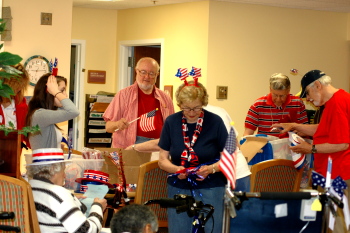 |
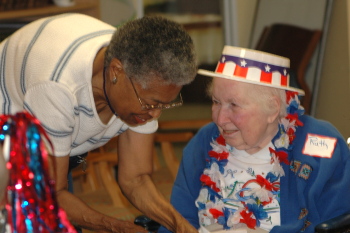 |
Promptly at 10:00 a.m., the parade began.
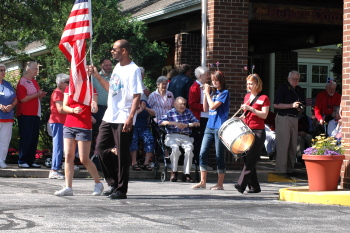 |
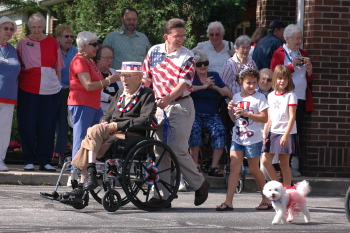 |
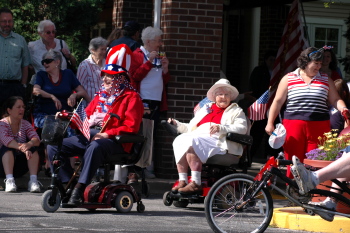
Coming around the circle, the parade heads toward the waiting crowd.
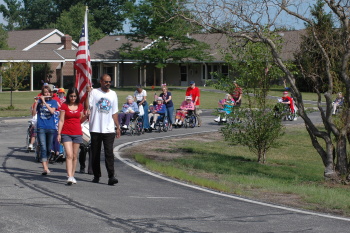 |
 |
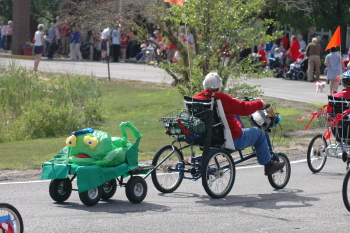
An eagerly anticipated part of any Oberlin parade is the Kendal Precision Lawn Chair Drill Team, led by Harvey Culbert.

They wave their chairs.
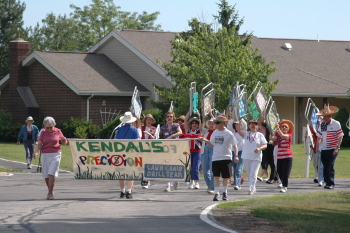
They circle as they sing.
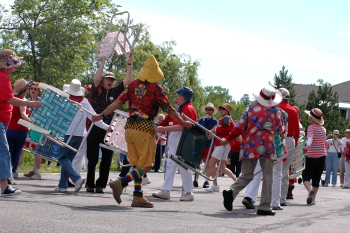
They sit to "inspect arms."
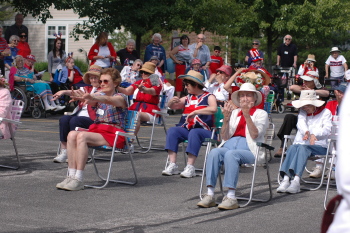
New this year was yet another precision drill team - this one with umbrellas.
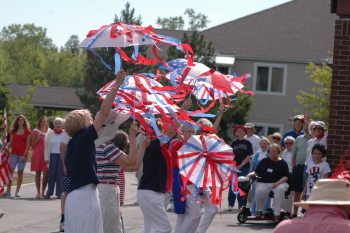
After the parade was over, we all gathered in the Auditorium for the morning’s program.
Kendal at Oberlin's 4th of July Program for 2009
Welcome to Kendal at Oberlin's annual 4th of July celebration. First, I'd like to acknowledge the many, many people who've made our program today possible: our co-coordinators, Ben and Pam Lenz; our musicians — Jara Stull on drums; Sarah Lynn on “fife”, also known as the piccolo; Marian Lott and Martha Stacy on piano; Jane Hannauer on guitar; George Hannauer, our sing-along leader; our stageful of Koradettes, led by June Swartwout; our readers, whom you'll meet as we go along; our audio expert, Russ Bimber; our photographer, Barry Walker; our flag bearers, Marlee McDonough and Michael Scott; and a special thanks to Doris Sable, whose American flag has been carried every 4th of July since the very first parade sixteen years ago.
To begin our time together this morning, we will have the presentation of that flag. You are welcome to stand if you like. And now, let's all join in singing a song that expresses so well the love we feel for — and the pride we take in — our country, especially on this day each year: America the Beautiful. The words, if you need them, are on your songsheets.
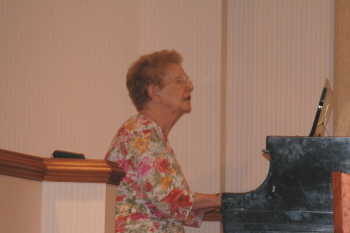
Oh beautiful for spacious skies, for amber waves of grain.
For purple mountain majesties above the fruited plain.
America! America! God shed His grace on thee,
And crown thy good with brotherhood from sea to shining sea.
Oh beautiful for pilgrim feet whose stern impassioned stress
A thoroughfare for freedom beat across the wilderness.
America! America! God mend thine ev'ry flaw.
Confirm thy soul in self-control, thy liberty in law.
Oh beautiful for patriot dream that sees beyond the years.
Thine alabaster cities gleam undimm'd by human tears.
America! America! God shed His grace on thee,
And crown thy good with brotherhood from sea to shining sea.
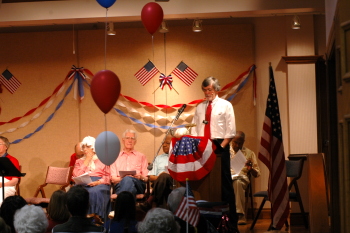
I'd like to talk with you a bit this morning about what I believe to be six of the most important words in the Preamble to our U. S. Constitution — “to form a more perfect union.” Strict grammarians would quibble with that construction, believing that “perfect” is one of those words, like “unique,” that cannot be qualified. But I believe history has proven that the writers of this Preamble, in fact, stated their hopes and expectations in exactly the right way.
The form of government they created was indeed “more perfect” than those that had gone before, but it fell short of “absolute perfection” in some significant ways. It has been up to us, “We the People,” those to whom this Preamble was addressed, to speak out, write, march, demonstrate, educate, organize, cajole, petition, do the many things that have been necessary to correct the omissions, right the wrongs, and broaden the horizons of the great and, yes, noble experiment in self-government that began on this day 233 years ago.
Those who see the Constitution of the United States as some kind of untouchable “holy writ” that codified the way our lives are to be lived, forever and ever, do not, in my opinion, really understand the thinking — and confusion and dissent and compromise — that went into its creation. Let’s look now at three crucial lapses in that Constitution, as originally written — the continuation of the institution of slavery; the denial of the vote to African-Americans; and the denial of the vote to women — and examine the ways in which all three have been brought, during the years that followed, closer to the ideal of perfection.
One woman who was “present at the creation” of our form of government, and who also had a very clear view of what was being left out of the deliberations, was Abigail Adams, wife of Founding Father John Adams and later the second First Lady of the United States. While John was away in Philadelphia helping the colonists start a revolution, he and Abigail, who stayed home in Braintree, near Boston, kept up a voluminous correspondence.
In one particularly memorable letter, written on March 31, 1776 — three months before the Declaration of Independence was signed — Abigail [read for us by Etta Ruth Weigl] said this:
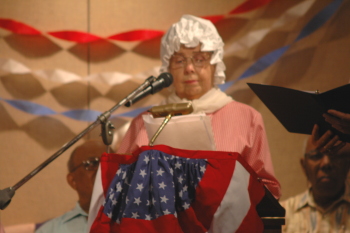
“I long to hear that you have declared an independency — and by the way, in the new Code of Laws which I suppose it will be necessary for you to make, I desire you would Remember the Ladies, and be more generous and favorable to them than your ancestors. Do not put such unlimited power into the hands of the Husbands. Remember all Men would be tyrants if they could. If particular care and attention is not paid to the Ladies, we are determined to foment a Rebellion, and will not hold ourselves bound by any Laws in which we have no voice, or Representation.
“That your sex are naturally tyrannical is a Truth so thoroughly established as to admit of no dispute, but such of you as wish to be happy willingly give up the harsh title of Master for the more tender and endearing one of Friend. Why then, not put it out of the power of the vicious and the lawless to use us with cruelty and indignity with impunity. Men of sense in all ages abhor those customs which treat us only as the vassals of your sex.”
John Adams, who as you can see was married to one of the most intelligent and far-sighted women of his — or any other — time, still chose to patronize her. In his reply, written on April 14, 1776, he said:
“As to your extraordinary Code of Laws, I cannot but laugh. We have been told that our struggle has loosened the bands of Government everywhere. That children and apprentices were disobedient — that schools and colleges were grown turbulent — that Indians slighted their Guardians and Negroes grew insolent to their Masters. But your letter was the first intimation that another Tribe, more numerous and powerful than all the rest, were grown discontented . . . . ”
“Depend upon it, we know better than to repeal our Masculine systems. Altho they are in full force, you know they are little more than Theory. We dare not exert our Power in its full latitude. We are obliged to go fair, and softly, and in practice you know We are the subjects. We have only the name of Masters, and [giving this up] would completely subject us to the Despotism of the Petticoat.”
Abigail was not amused. In her reply, dated May 7, she said:
“I cannot say that I think you very generous to the Ladies, for whilst you are proclaiming peace and good will to Men, emancipating all Nations, you insist upon retaining an absolute power over Wives. But you must remember that arbitrary power is like most other things which are very hard, very liable to be broken — and notwithstanding all your wise Laws and Maxims we have it in our power not only to free ourselves but to subdue our Masters, and without violence throw both your natural and legal authority at our feet . . . .”
In this, Abigail Adams was, of course, absolutely correct — she was only about a hundred and fifty years ahead of the fulfillment of her prophecy.
Another man who played a pivotal role in the creation of the new United States was Benjamin Franklin. He was also a very wise and clear-headed person, and he had his own reservations about the details, even the effectiveness, of the form of government that was being hammered out. In a speech he gave to the Constitutional Convention as it neared its end in the summer of 1787, Franklin [read for us by David Schaal] said this:
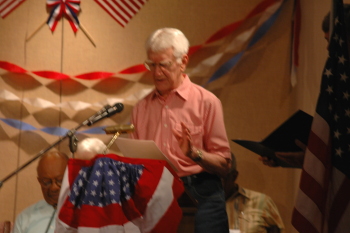
“I confess that I do not entirely approve this Constitution at present, but Sir, I am not sure I shall never approve it: For having lived long, I have experienced many Instances of being oblig’d, by better Information or fuller Consideration, to change Opinions even on important Subjects, which I once thought right, but found to be otherwise. . .
“In these sentiments, Sir, I agree to the Constitution, with all its Faults, if they are such; because I think a General Government necessary for us, and there is no Form of Government but what may be a Blessing to the People if well administered; and I believe farther that this is likely to be well administered for a Course of Years, and can only end in Despotism as other Forms have done before it, when the People shall become so corrupted as to need Despotic Government, being incapable of any other.
“I doubt too whether any other Convention we can obtain, may be able to make a better Constitution: For when you assemble a Number of Men to have the Advantage of their joint Wisdom, you inevitably assemble with those Men all their Prejudices, their Passions, their Errors of Opinion, their local Interests, and their selfish Views. From such an Assembly, can a perfect Production be expected? It therefore astonishes me, Sir, to find this System approaching so near to Perfection as it does. . . Thus I consent, Sir, to this Constitution because I expect no better, and because I am not sure that it is not the best.”
As the English philosopher Alfred North Whitehead said in 1954: “The men who founded your republic had an uncommonly clear grasp of the general ideas that they wanted to put in here, then left the working out of the details to later interpreters, which has been, on the whole, remarkably successful.”
This “working out of the details” began immediately — even before the Constitution, as written, had been ratified and become the law of the land. When the Constitutional Convention completed its work in the fall of 1787, the document it submitted to the thirteen states for their approval did not contain a bill of rights. The framers had decided that a listing of rights was unnecessary since it was clear to them that all rights not specifically granted to the government through the Constitution remained with the people.
Those people themselves, however, were skeptical of such high-flown philosophizing. They wanted their rights clearly spelled out in black and white. They were well aware of the precedents in the Magna Carta, the English common law, and the Virginia Declaration of Rights of 1776. They wanted the same kind of rights — written down — to restrict the power of this new federal government. The Constitution was to take effect as soon as nine states had ratified it, but significant opposition centered on the lack of a bill of rights. Such an addition was promised, however, and ratification was completed in 1788. The first Congress proposed twelve amendments, ten of which were approved by the states and added to the Constitution in December 1791.
As for slavery, the question of what to do about it had a long and turbulent history in these colonies. In fact, slaves from Africa came to these shores very soon after the first English settlers did. In his book called The Civil Rights Act of 1964: The Passage of the Law That Ended Racial Segregation, Robert Loevy, professor of political science at Colorado College, describes what happened this way:
“The first permanent English colony in North America was founded at Jamestown, Virginia, in May 1607. Twelve years later, in 1619, a Dutch ship sailed into the harbor at Jamestown and sold twenty African slaves to the Virginia colonists. Thus did ‘slavery’ and ‘involuntary servitude,’ as they are referred to in the United States Constitution, come to the American South.
“Negro slaves, brought in chains from their original homelands in central and southern Africa, proved useful and profitable in what was to become the southern United States. The flat farmlands, served by meandering tidewater rivers, were ideal for creating large plantations for growing cotton and other agricultural products. The African slaves provided a cheap and reliable source of agricultural and household labor for the emerging southern economy.
“North of Virginia, where there were more hills and a harsher climate, the use of human slaves was not as successful. This part of the American colonies, the North, harnessed the labor of yeoman farmers and men and women working for wages. This created one of the great sectional differences of United States history — a group of southern states that relied heavily on slave labor and a group of northern states emphasizing the work and industry of free citizens.
“By the time of the Declaration of Independence in 1776, there were almost half a million black persons in the colonies. A thriving slave trade had developed in which men, women, and children were sold, often at public auction, from one owner to another. Thomas Jefferson, a slave holder from Virginia, had included a condemnation of the human slave trade in the original draft of the Declaration of Independence, but his impassioned words were deleted to keep the support of the southern colonies during the Revolutionary War against Great Britain.
“The United States next confronted the slavery problem at the time of the drawing up of the federal Constitution at Philadelphia, Pennsylvania, in the summer of 1787. The delegates provided for the abolition of the importation of slaves twenty years after the Constitution was adopted, but the institution of slavery was allowed to remain. In addition, in a famous compromise, each slave was to be counted as ‘three-fifths’ of a person for establishing how many representatives each state could have in the lower house, the House of Representatives, of the national Congress.”
Few men — even those like John Adams who had it called forcefully to their attention — even considered the possibility that women should participate in any significant way in the governing of what was, after all, their country, too. On the other hand, however, the continuation of the institution of slavery in the American South was the subject of a great deal of thought and clashes of philosophies during the deliberations engaged in by our Founding Fathers. One of the most cogent — and most powerful — examinations of how all this came about was given by Thurgood Marshall, the grandson of a slave and the first African-American justice appointed to the U. S. Supreme Court, in remarks he made at a seminar in San Francisco in May of 1987. Justice Marshall had apparently been invited to participate in the celebration that year of the 200th anniversary of the United States Constitution. In his remarks in San Francisco, Justice Marshall [read for us by Al McQueen] said this:
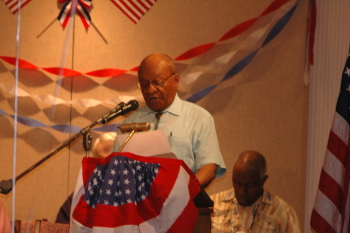
“Like many anniversary celebrations, the plan for 1987 takes particular events and holds them up as the source of all the very best that has followed. Patriotic feelings will surely swell, prompting proud proclamations of the wisdom, foresight, and sense of justice shared by the framers and reflected in a written document now yellowed with age. This is unfortunate — not the patriotism itself, but the tendency for the celebration to oversimplify and overlook the many other events that have been instrumental to our achievements as a nation. The focus of this celebration invites a complacent belief that the vision of those who debated and compromised in Philadelphia yielded the ‘more perfect Union’ it is said we now enjoy.
“I cannot accept this invitation, for I do not believe that the meaning of the Constitution was forever ‘fixed’ at the Philadelphia Convention. Nor do I find the wisdom, foresight, and sense of justice exhibited by the framers particularly profound. To the contrary, the government they devised was defective from the start, requiring several amendments, a civil war, and momentous social transformation to attain the system of constitutional government, and its respect for the individual freedoms and human rights, we hold as fundamental today. When contemporary Americans cite ‘The Constitution,’ they invoke a concept that is vastly different from what the framers barely began to construct two centuries ago.
“For a sense of the evolving nature of the Constitution, we need to look no further than the first three words of the document’s preamble: ‘We the People.’ When the Founding Fathers used this phrase in 1787, they did not have in mind the majority of America’s citizens. ‘We the People’ included, in the words of the framers, ‘the whole Number of free Persons.’ On a matter so basic as the right to vote, for example, Negro slaves were excluded, although they were counted for representational purposes — at three-fifths each. Women did not gain the right to vote for over a hundred and thirty years. These omissions were intentional . . .
“No doubt it will be said, when the unpleasant truth of the history of slavery in America is mentioned during this bicentennial year, that the Constitution was a product of its times and embodied a compromise that, under other circumstances, would not have been made. But the effects of the framers’ compromise have remained for generations. They arose from the contradiction between guaranteeing liberty and justice to all, and denying both to Negroes. The original intent of the phrase, ‘We the People,’ was far too clear for any ameliorating construction.”
After these compromises had been made, and had become entrenched in American life, and liberty and justice continued not to be applied to African-Americans, a strong movement for the abolition of slavery began to grow in the northern states. One of its most eloquent voices was that of a man who had been a slave himself, Frederick Douglass. Born in Maryland in 1818, Douglass managed to learn to read — something strictly forbidden to all slaves — and was soon devouring every book and newspaper he could get his hands on. He then kept getting into serious trouble for teaching other slaves to read.
In 1838, he escaped from his master — who had feared that Douglass’s knowing how to read would lead to just such an eventuality — and went by train to Philadelphia, New York City, and on to New Bedford, Massachusetts. He quickly became a leader in the abolition movement, first questioning and then condemning the institution of slavery. He also, as you will see, had learned to write with stunning eloquence and persuasiveness.
In an essay he published in 1860 called “The Constitution of the United States: Is it Pro-Slavery or Anti-Slavery?,” Douglass [read for us by Del Jenkins] challenged the accepted interpretations of what the Constitution says in this way:

“I only ask you to look at the American Constitution . . . and you will see with me that no man is guaranteed a right of property in man, under the provisions of that instrument. If there are two ideas more distinct in their character and essence than another, those ideas are ‘persons’ and ‘property,’ ‘men’ and ‘things.’ Now, when it is proposed to transform persons into ‘property’ and men into beasts of burden, I demand that the law that contemplates such a purpose shall be expressed with irresistible clearness. The thing must not be left to inference, but must be done in plain English.
“I know how this view of the subject is treated by the class represented at the City Hall. They are in the habit of treating the Negro as an exception to general rules. When their own liberty is in question, they will avail themselves of all rules of law which protect and defend their freedom; but when the black man’s rights are in question, they concede everything, admit everything for slavery, and put liberty to the proof. They reverse the common law usage, and presume the Negro a slave unless he can prove himself free. I, on the other hand, presume him free unless he is proved to be otherwise.
“Let us look at the objects for which the Constitution was framed and adopted, and see if slavery is one of them. Here are its own objects as set forth by itself — ‘We, the people of these United States, in order to form a more perfect union, establish justice, ensure domestic tranquility, provide for the common defense, promote the general welfare, and secure the blessings of liberty to ourselves and our posterity, do ordain and establish this Constitution for the United States of America.’ The objects here set forth are six in number: union, defense, welfare, tranquility, justice, and liberty. These are all good objects, and slavery, so far from being among them, is a foe of them all . . .
“The constitutionality of slavery can be made out only by disregarding the plain and common-sense reading of the Constitution itself; by discrediting and casting away as worthless the most beneficent rules of legal interpretation; by ruling the Negro outside of these beneficent rules; by claiming everything for slavery; by denying everything for freedom; by assuming that the Constitution does not mean what it says, and that it says what it does not mean; by disregarding the written Constitution, and interpreting it in the light of a secret understanding.”
One of the most fascinating aspects, to me, of the history of these times is that the movements for the abolition of slavery and for the establishment of women’s rights overlapped to such a significant degree. Two of the earliest leaders of the women’s rights movement, Elizabeth Cady Stanton and Lucretia Mott, met in 1840 in London at the World Anti-Slavery Convention.
“Another extremely important example of this convergence is that Frederick Douglass, who was then living in Rochester, New York, himself attended the first women’s rights convention in Seneca Falls in 1848, the only African-American among the three hundred or so people who gathered there.
One of the convention’s leaders, Elizabeth Cady Stanton, had drafted eleven resolutions, which argued that women had a natural right to equality in all spheres, including marriage, divorce, property, education, the guardianship of children, and profitable employment. One of these resolutions proposed the radical idea that it was the duty of women to secure for themselves the right to vote. Lucretia Mott, another of the leaders, was shocked at the idea, but Stanton remained firm.
“I persisted,” she said later, “for I saw clearly that the power to make laws was the right through which all other rights could be secured.”
All of the proposed resolutions were passed unanimously, except for the one on woman suffrage. In the midst of the heated discussion that ensued, Frederick Douglass rose to speak forcefully in favor of this remaining resolution. He said he could not accept the right to vote himself as a black man so long as women were denied that same right. He said, further, that he believed the world would be a better place if women were involved in making political decisions. “In this denial of the right to participate in government,” he said, “not merely the degradation of woman and the perpetuation of a great injustice happens, but the maiming and repudiation of one-half of the moral and intellectual power of the government of the world.” After Douglass’s speech, the resolution — which recognized women’s “inalienable right to the elective franchise” — passed by a large majority.
It became a part of the Seneca Falls Declaration of Sentiments and Resolutions, which was then signed by 68 women and 32 men, among them Frederick Douglass and two great-grandfathers of our own Jane Hannauer.
As I was doing my research for this program, I was lucky enough to find a song that was sung at the National-American Woman’s Suffrage Convention of 1891. The words, set to the same music as “My Country, ’Tis of Thee,” reflect a common suffrage argument of the time — that giving the vote to women was simply a way to fulfill the promise first made in 1776.
Here are the Koradettes, led by June Swartwout, with Martha Stacy at the piano, singing
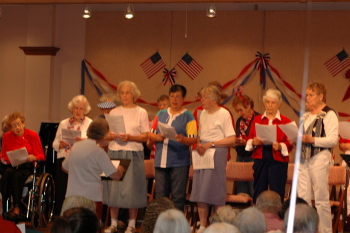
A New America
We have printed the words on your songsheets in case you’d like to follow along:
Our country, now from thee claim we our liberty in freedom’s name.
Guarding home’s altar fires, daughters of patriot sires,
Their zeal our own inspires justice to claim.
Women in every age for this great heritage tribute have paid.
Our birth-right claim we now, longer refuse to bow,
On freedom’s altar now our hand is laid.
Sons, will you longer see mothers on bended knee for justice pray?
Rise now, in manhood’s might, with earth’s great souls unite
To speed the dawning light of freedom’s day.
Another powerful and eloquent voice in both the abolition and the woman suffrage movements was that of Lucy Stone, who, coincidentally, was born in the same year as Frederick Douglass — 1818 — on her family’s farm in West Brookfield, Massachusetts. The eighth of nine children, she was an extraordinarily independent-minded girl, who from her youngest years challenged her mother’s docile submission to her hard-drinking and belligerent father and who worked diligently to prove herself not only equal, but superior, to her brothers scholastically.
She succeeded so well that in August of 1843, she traveled by train, steamship, and stagecoach to Ohio to enter Oberlin College. By this time, she already believed, quite strongly, that women should vote, should hold public office, should be able to study for whatever profession they chose, and should be allowed to speak their minds in public forums.
As the end of her final year of college approached, Lucy Stone was selected by a vote of her classmates to write a commencement speech for them. However, when she discovered that she would not be allowed to read the address herself — that a male professor would do so since it was considered improper for a woman to speak in front of both men and women — she refused to write it. All of the other students who were asked to replace her refused as well.
You go, Oberlin!
Those poor men, alas, were no match for Lucy Stone’s determination. In a letter to her mother, written in March of 1847, just before her graduation, she said, “I expect to plead not for the slave only, but for suffering humanity everywhere. Especially do I mean to labor for the elevation of my sex.”
And did she ever!
After her graduation, with honors, from Oberlin College in June of 1847, the first woman from Massachusetts to earn a college degree, Lucy Stone began finding a great many public forums where she was allowed to speak, which she did with enormous vigor — and with overwhelming success. In a speech before the National Women’s Rights Convention in Cincinnati in October 1855, Lucy Stone [read for us by Jane Hannauer] said this:

“The last speaker alluded to this movement as being that of a few disappointed women. From the first years to which my memory stretches, I have been a disappointed woman. When, with my brothers, I reached forth after the sources of knowledge, I was reproved with ‘It isn’t fit for you; it doesn’t belong to women.’ Then, there was but one college in the world where women were admitted, and that was in Brazil. I would have found my way there, but by the time I was prepared to go, one was opened in the young State of Ohio — the first in the United States where women and Negroes could enjoy opportunities with white men.
“I was disappointed when I came to seek a profession worthy an immortal being — every employment was closed to me, except those of the teacher, the seamstress, and the housekeeper. In education, in marriage, in religion, in everything, disappointment is the lot of woman. It shall be the business of my life to deepen this disappointment in every woman’s heart until she bows down to it no longer. I wish that women, instead of being walking show-cases, instead of begging of their fathers and brothers the latest and gayest new bonnet, would ask of them their rights.
“The question of Woman’s Rights is a practical one. The notion has prevailed that it was only an ephemeral idea; that it was but women claiming the right to smoke cigars in the streets, and to frequent bar-rooms. Others have supposed it a question of comparative intellect; others still, of sphere. . .
“Leave women, then, to find their sphere. And do not tell us before we are born even, that our province is to cook dinners, darn stockings, and sew on buttons. We are told woman has all the rights she wants; and even women, I am ashamed to say, tell us so. They mistake the politeness of men for rights — seats while men stand in this hall tonight, and their adulations; but these are mere courtesies. We want rights.”
Although she was such an ardent early feminist, Lucy Stone finally gave in to the entreaties of Henry Browne Blackwell and married him in that same year of 1855. However, she stuck to her principles by becoming the first American woman we know of to keep her own family name after she was married. She said at the time, “A wife should no more take her husband’s name than he should take hers.”
Not long after that convention was held, the Civil War began, hundreds of thousands of young American men were killed and wounded, President Abraham Lincoln issued his Emancipation Proclamation, and the war finally ended in the spring of 1865.
A great deal of that “working out of the details” cited by Alfred North Whitehead began to occur relatively quickly during the next few years. Slavery was outlawed everywhere in the United States by the ratification, in December of 1865, of the 13th Amendment to the Constitution. It is estimated that some four million black slaves were freed between 1861 and 1865.
Two additional amendments soon followed: the 14th, ratified in 1868, which guaranteed citizenship for “all persons born or naturalized in the United States, and subject to the jurisdiction thereof,” and also guaranteed equal protection under the law to all such citizens; and the 15th, ratified in 1870, which protected U. S. citizens from being denied the right to vote because of “race, color, or previous condition of servitude.”
After all of this concerted activity, conditions did indeed improve for American blacks, but only in some areas of their lives and only for a very brief time. It didn’t take long for the forces arrayed against them to gather strength and find new, often ingenious, ways of denying the right to vote — which, at that time, of course, still applied only to men and not to women — that had been so recently granted.
Such blatant obstacles as literacy tests, poll taxes, and both psychological and brutally physical intimidation worked only too well. Aided and abetted by all three branches of the national government — in some ways most effectively by the U. S. Supreme Court — the country’s white majority succeeded in restoring what many believed to be the proper order of things.
During the years after the Civil War ended, the movement for woman suffrage, which had begun way back in Seneca Falls in 1848, went through many ups and downs, including schisms, reconciliations, and passionate arguments over tactics, strategy, and achievable goals. Although some states began granting women the right to vote on their own, many others did not. The different factions in the suffrage movement finally came together and agreed that the only lasting solution was an amendment to the U.S. Constitution — yet another of Alfred North Whitehead’s “working out of the details.”
In 1912, the movement got a huge boost when Theodore Roosevelt’s Progressive Party became the first national political party to adopt a woman suffrage plank in its platform. Five years later, in 1917, one of the leaders of the suffrage movement, Carrie Chapman Catt, spoke before the U. S. Congress. Here [read for us by Vi Blount] is part of what she said:

“Ours is a nation born of revolution, of rebellion against a system of government so securely entrenched in the customs and traditions of human society that in 1776 it seemed impregnable. From the beginning of things, nations had been ruled by kings and for kings, while the people served and paid the cost. The American Revolutionists boldly proclaimed the heresies: ‘Taxation without representation is tyranny.’ ‘Governments derive their just powers from the consent of the governed.’
“The colonists won, and the nation which was established as a result of their victory has held unfailingly that these two fundamental principles of democratic government are not only the spiritual source of our national existence but have been our chief historic pride and at all times the sheet anchor of our liberties.
“Eighty years after the Revolution, Abraham Lincoln welded those two maxims into a new one: ‘Ours is a government of the people, by the people, and for the people.’ Fifty years more passed, and the president of the United States, Woodrow Wilson, in a mighty crisis of the nation, proclaimed to the world: ‘We are fighting for the things which we have always carried nearest to our hearts: for democracy, for the right of those who submit to authority to have a voice in their own government.’ . . .
“With such a history behind it, how can our nation escape the logic it has never failed to follow, when its last unenfranchised class calls for the vote? . . . It is too obvious to require demonstration that woman suffrage . . . will eventually be ordained in all the nation. No one will deny it. The only question left is when and how will it be completely established.”
The answer to her question of “how” was the 19th Amendment to the Constitution, which, as proposed, read this way: “The right of citizens of the United States to vote shall not be denied or abridged by the United States or by any State on account of sex.”
The answer to the question of “when” was “soon.” On May 21, 1919, the U. S. House of Representatives passed the amendment, and two weeks later, the Senate did as well. On August 18, 1920, when Tennessee became the 36th state to ratify, the amendment passed its final hurdle. A week later, on August 26, when the United States Secretary of State certified the ratification, American women at last — at long last — achieved the equality they had been denied.
We can all be sure that, wherever she may have been, Abigail Adams was smiling.
This left African-Americans, women now as well as men, in the intolerable position of being “officially” eligible to vote, but in most cases unable to do so. The situation began to change thirty-five years later on December 1, 1955, in Montgomery, Alabama, when a black woman named Rosa Parks refused to give up her seat on a city bus to a white passenger, and the American Civil Rights Movement was set in motion.
What I remember most clearly about those years, when my own social consciousness began to be born, is a song that has echoed in my memory from that time to this — a song that expressed, with unmatched simplicity and gentle beauty, the feeling of hope and promise of a better day that so many of us felt, as we embarked on that long, painful struggle for justice and equality. With Jane Hannauer on the guitar and led by George Hannauer, let’s sing together
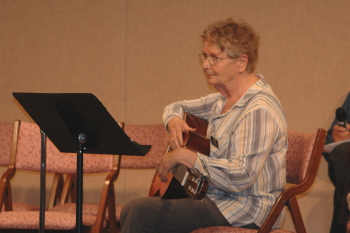 |
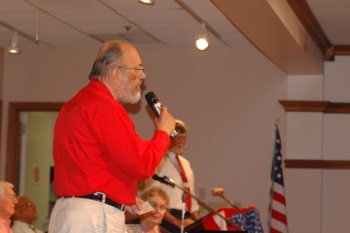 |
|
We Shall Overcome
We shall overcome, we shall overcome,
we shall overcome someday.
Oh, deep in my heart I do believe we shall overcome someday.
We’ll walk hand in hand, we’ll walk hand in hand,
We’ll walk hand in hand someday.
Oh, deep in my heart I do believe we shall overcome someday.
We shall live in peace, we shall live in peace,
We shall live in peace someday.
Oh, deep in my heart I do believe we shall overcome someday.
We shall all be free, we shall all be free,
we shall all be free someday.
Oh, deep in my heart I do believe we shall overcome someday.
On March 15, 1965, ten agonizing years after Rosa Parks first lit her fuse, President Lyndon B. Johnson went before a joint session of Congress to give the first speech of this kind in American history to be broadcast on nationwide television. In his speech, President Johnson quoted from the song we’ve just sung as he made his heartfelt plea for passage of the bill he would be introducing to Congress. Here [read for us by Bob Baldwin] is some of what he said:
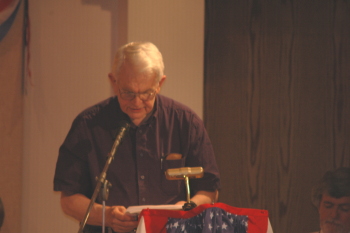
“Many of the issues of civil rights are very complex and most difficult. But about this there can and should be no argument. Every American citizen must have an equal right to vote. There is no reason which can excuse the denial of that right. There is no duty which weighs more heavily on us than the duty we have to ensure that right . . .
“Wednesday I will send to Congress a law designed to eliminate illegal barriers to the right to vote . . . This bill will strike down restrictions to voting in all elections — Federal, State, and local — which have been used to deny Negroes the right to vote. This bill will establish a simple, uniform standard which cannot be used, however ingenious the effort, to flout our Constitution . . .
“To those who seek to avoid action by their National Government in their own communities, who want to and who seek to maintain purely local control over elections, the answer is simple: Open your polling places to all your people. Allow men and women to register and vote whatever the color of their skin.
“Extend the rights of citizenship to every citizen of this land . . .
“What happened in Selma is part of a far larger movement which reaches into every section and State of America. It is the effort of American Negroes to secure for themselves the full blessings of American life.
“Their cause must be our cause, too. Because it is not just Negroes, but really it is all of us, who must overcome the crippling legacy of bigotry and injustice.
“And we shall overcome.”
Two days later, on March 17, President Johnson sent his Voting Rights Act to Congress, and, after both houses had passed it, he signed it into law on August 6, 1965.
Forty-three years after that, in November of 2008, this centuries-long struggle for true liberty and equality reached a pinnacle of earthshaking importance, when millions of Americans — men and women, blacks, whites, Hispanics, Asians, naturalized citizens who’d come here from many of the countries of the world — went to the polls and elected the first African-American President of the United States, someone who “perfectly” embodies that phrase — a man with a black African father and a white American mother, neither of whom could have voted during the first one hundred and thirty years of this nation’s existence.
Soon after he was elected to be a Senator from the state of Illinois, Barack Obama published a book called The Audacity of Hope. In the final paragraphs of the epilogue to that book, he talks about the days, not so long ago, when he was still able to wander, alone, wherever he wanted to in Washington, D.C.
He says he often liked to “take a run along the Mall. Usually I go in the early evening, especially in the summer and fall, when the air in Washington is warm and still and the leaves on the trees barely rustle. After dark, not many people are out — perhaps a few couples taking a walk, or homeless men on benches, organizing their possessions. Most of the time I stop at the Washington Monument, but sometimes I push on, across the street to the National World War II Memorial, then along the Reflecting Pool to the Vietnam Veterans Memorial, then up the stairs of the Lincoln Memorial.
“At night, the great shrine is lit but often empty. Standing between marble columns, I read the Gettysburg Address and the Second Inaugural Address. I look out over the Reflecting Pool, imagining the crowd stilled by Dr. King’s mighty cadence, and then beyond that, to the floodlit obelisk and shining Capitol dome.
“And in that place, I think about America and those who built it. This nation’s founders, who somehow rose above petty ambitions and narrow calculations to imagine a nation unfurling across a continent. And those like Lincoln and King, who ultimately laid down their lives in the service of perfecting an imperfect union. And all the faceless, nameless men and women, slaves and soldiers and tailors and butchers, constructing lives for themselves and their children and grandchildren, brick by brick, rail by rail, calloused hand by calloused hand, to fill in the landscape of our collective dreams.
“It is that process I wish to be a part of.
“My heart is filled with love for this country.”
To help bring our time together this morning to a close, let’s follow the Quaker tradition and observe a moment of silence, to give our hearts and minds an opportunity to absorb what we have heard here today.
And now, let’s stand together, if you can, and sing our traditional Kendal at Oberlin 4th of July finale — This Land Was Made for You and Me!
(Chorus) This land is your land, this land is my land,
From California to the New York island,
From the redwood forest to the Gulf Stream waters,
This land was made for you and me.
As I was walking that ribbon of highway,
I saw above me that endless skyway.
I saw below me those golden valleys.
This land was made for you and me. (Chorus)
I’ve roamed and rambled, and I’ve followed my footsteps
To the sparkling sands of her diamond deserts.
And all around me a voice was chanting:
“This land was made for you and me.” (Chorus)
Nobody living can ever stop me,
As I go walking that freedom highway.
Nobody living can make me turn back.
This land was made for you and me. (Chorus)



















